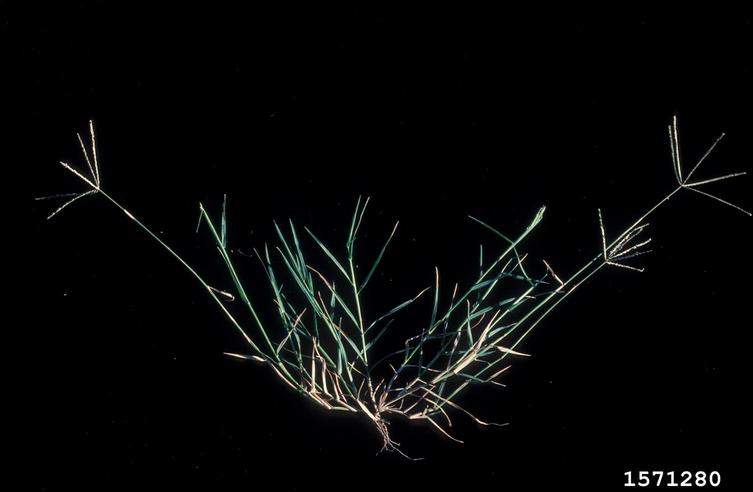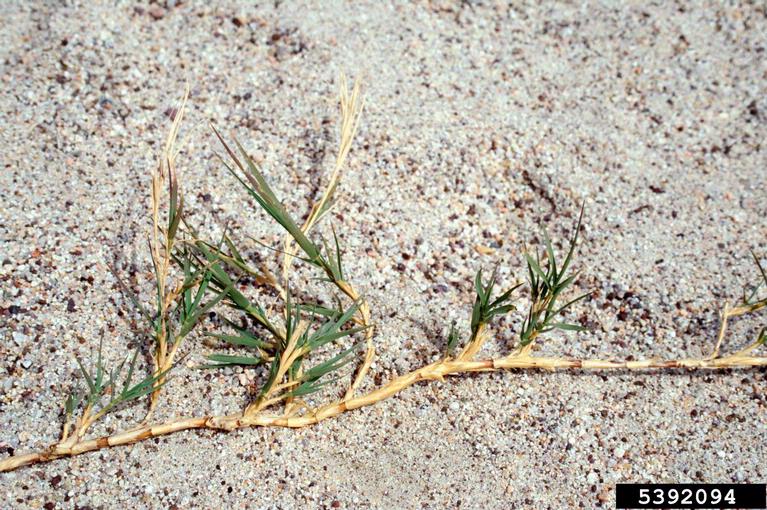 Bermudagrass Management - August 9, 2107 Jeff Schalau, Agent, Agriculture & Natural Resources University of Arizona Cooperative Extension, Yavapai County Bermudagrass (Cynodon dactylon) is a plant that can be grown intentionally as a turfgrass or livestock forage. It has also become a serious invasive weed. Bermudagrass was introduced from Africa in 1751 and is widely spread throughout the southwest and southern United States. It is found in most areas of the Verde Valley invading gardens, landscapes, orchards, roadsides, vineyards, and industrial areas. Bermudagrass is a low-growing, warm-season, wiry perennial that has two types of shoots: aboveground stolons and belowground rhizomes. The stolons and rhizomes are capable of rooting in the soil, thus creating new plants as they grow out from the original plant or when they are cut and left on moist soil. In areas where the soil has not been disturbed or regularly irrigated, rhizomes are often shallow (1 to 6 inches). But where the soil has been plowed and/or irrigated, the rhizomes may be deeper than 6 inches and could extend for several feet. The flowering stems are upright with three to seven spike-like branches usually originating from a single whorl on the tip of the stem. Bermudagrass is not an easy weed to control. Herbicide application is effective but requires careful timing and usually, more than one application. There are two basic types of herbicides that can kill mature bermudagrass, nonselective herbicides that kill most plant species and selective herbicides that only kill plants in the grass family. Glyphosate is the active ingredient in many nonselective herbicides. Glyphosate is applied and translocated to the root system. For glyphosate to be most effective it must be applied to bermudagrass that is vigorously growing, not drought stressed, and has lots of leaf surface (do not mow the weed for 2 to 3 weeks before treating). Some people also fertilize the bermudagrass a week or so before treatment. The best time of the year to apply glyphosate is during mid to late summer when the plant is storing energy in its roots. You should wait seven days after applying to mow or cultivate the bermudagrass. A second or third application may be required to completely kill well established stands. Be sure to follow label directions on all pesticides. Where bermudagrass has invaded broadleaf shrubs and groundcovers, there are grass-selective herbicides which contain one of the following active ingredients: sethoxydim, fluazifop, or clethodim. These products kill bermudagrass (and other perennial weedy grasses) and not affect broadleaf plants. For best control with these herbicides, make the first application in spring when new bermudagrass growth is less than 6 inches in length, then re-apply the herbicide before the regrowth reaches 6 inches again. Additional applications on regrowth may be needed through the summer. Bermudagrass can also be managed non-chemically with black plastic or weed barrier. It requires persistent removal of aboveground shoots and is rarely 100% successful. I understand that many gardeners are not comfortable using herbicides and other chemicals. If you are in this camp, try these mulching techniques. Black polyethylene sheets placed over established bermudagrass prevents sunlight from reaching the plant and can be an effective control. Mow and irrigate the grass, place the plastic over the plants, seal the edges with soil, and leave it for at least 6 to 8 weeks in summer. Placing plastic over bermudagrass in winter will not control it. Be sure that the plastic remains intact without holes, or bermudagrass will grow through the holes and survive. Weed barrier (a woven plastic mulch sold in rolls) can be used similarly and is more resistant to foot traffic. Many gardeners question the safety of glyphosate. In November 2015, The European Food Safety Authority (EFSA) said that glyphosate was unlikely to cause cancer in humans and proposed higher limits on the amount of residue of the herbicide deemed safe for humans to consume. In the United States, glyphosate is undergoing a routine registration review (a process that re-evaluates all pesticides on a 15-year cycle). If you have bermudagrass or other difficult-to-manage perennial weeds, I suggest you evaluate your site and your values, then decide for yourself as to whether you want to use herbicides or not. Glyphosate is effective on tough perennial weeds and can be used safely. If you decide not to used herbicides, you can use mulches and weed barriers. See below for photos and links to bermudagrass identification and management information. Follow the Backyard Gardener on Twitter – use the link on the BYG website. If you have other gardening questions, call the Master Gardener help line in the Camp Verde office at 928-554-8992 or e-mail us at verdevalleymg@gmail.com and be sure to include your name, address and phone number. Find past Backyard Gardener columns or provide feedback at the Backyard Gardener web site: http://cals.arizona.edu/yavapai/anr/hort/byg/. Photos  Bermudagrass (Cynodon dactylon) plant showing inflourescence and foliage (Gerald Holmes, California Polytechnic State University at San Luis Obispo, Bugwood.org).
Bermudagrass (Cynodon dactylon) plant showing inflourescence and foliage (Gerald Holmes, California Polytechnic State University at San Luis Obispo, Bugwood.org). Bermudagrass (Cynodon dactylon) plant showing rhizome (John M. Randall, The Nature Conservancy, Bugwood.org).
Bermudagrass (Cynodon dactylon) plant showing rhizome (John M. Randall, The Nature Conservancy, Bugwood.org).Additional Resources Killing Weeds in the Garden with Glyphosate Michigan State University Extension msue.anr.msu.edu/news/killing_weeds_in_the_garden_with_glyphosate Glyphosate United States Environmental Protection Agency www.epa.gov/ingredients-used-pesticide-products/glyphosate Controversial Weedkiller in Roundup 'does not cause cancer', says European Expert Committee The Independent www.independent.co.uk/environment/roundup-weedkiller-glyphosate-not-cancer-causing-european-expert-committee-echa-a7631796.html |